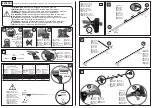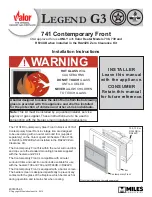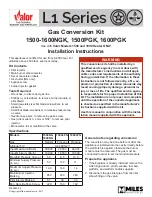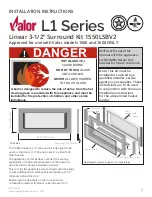
Safety
DANGER — MANY HAZARDS ARE ASSOCIATED WITH INSTALLING, USING, MAINTAINING, AND WORKING ON OR AROUND TRIPODS, TOWERS, AND ANY
ATTACHMENTS TO TRIPODS AND TOWERS SUCH AS SENSORS, CROSSARMS, ENCLOSURES, ANTENNAS, ETC. FAILURE TO PROPERLY AND COMPLETELY
ASSEMBLE, INSTALL, OPERATE, USE, AND MAINTAIN TRIPODS, TOWERS, AND ATTACHMENTS, AND FAILURE TO HEED WARNINGS, INCREASES THE RISK
OF DEATH, ACCIDENT, SERIOUS INJURY, PROPERTY DAMAGE, AND PRODUCT FAILURE. TAKE ALL REASONABLE PRECAUTIONS TO AVOID THESE
HAZARDS. CHECK WITH YOUR ORGANIZATION'S SAFETY COORDINATOR (OR POLICY) FOR PROCEDURES AND REQUIRED PROTECTIVE EQUIPMENT
PRIOR TO PERFORMING ANY WORK.
Use tripods, towers, and attachments to tripods and towers only for purposes for which they are designed. Do not exceed design limits. Be familiar and
comply with all instructions provided in product manuals. Manuals are available at
You are responsible for conformance with
governing codes and regulations, including safety regulations, and the integrity and location of structures or land to which towers, tripods, and any
attachments are attached. Installation sites should be evaluated and approved by a qualified engineer. If questions or concerns arise regarding installation,
use, or maintenance of tripods, towers, attachments, or electrical connections, consult with a licensed and qualified engineer or electrician.
General
l
Protect from over-voltage.
l
Protect electrical equipment from water.
l
Protect from electrostatic discharge (ESD).
l
Protect from lightning.
l
Prior to performing site or installation work, obtain required approvals and permits. Comply with all governing structure-height regulations, such as
those of the FAA in the USA.
l
Use only qualified personnel for installation, use, and maintenance of tripods and towers, and any attachments to tripods and towers. The use of
licensed and qualified contractors is highly recommended.
l
Read all applicable instructions carefully and understand procedures thoroughly before beginning work.
l
Wear a hardhat and eye protection, and take other appropriate safety precautions while working on or around tripods and towers.
l
Do not climb tripods or towers at any time, and prohibit climbing by other persons. Take reasonable precautions to secure tripod and tower sites
from trespassers.
l
Use only manufacturer recommended parts, materials, and tools.
Utility and Electrical
l
You can be killed or sustain serious bodily injury if the tripod, tower, or attachments you are installing, constructing, using, or maintaining, or a tool,
stake, or anchor, come in contact with overhead or underground utility lines.
l
Maintain a distance of at least one-and-one-half times structure height, 6 meters (20 feet), or the distance required by applicable law, whichever is
greater, between overhead utility lines and the structure (tripod, tower, attachments, or tools).
l
Prior to performing site or installation work, inform all utility companies and have all underground utilities marked.
l
Comply with all electrical codes. Electrical equipment and related grounding devices should be installed by a licensed and qualified electrician.
l
Only use power sources approved for use in the country of installation to power Campbell Scientific devices.
Elevated Work and Weather
l
Exercise extreme caution when performing elevated work.
l
Use appropriate equipment and safety practices.
l
During installation and maintenance, keep tower and tripod sites clear of un-trained or non-essential personnel. Take precautions to prevent
elevated tools and objects from dropping.
l
Do not perform any work in inclement weather, including wind, rain, snow, lightning, etc.
Internal Battery
l
Be aware of fire, explosion, and severe-burn hazards.
l
Misuse or improper installation of the internal lithium battery can cause severe injury.
l
Do not recharge, disassemble, heat above 100 °C (212 °F), solder directly to the cell, incinerate, or expose contents to water. Dispose of spent
batteries properly.
Use and disposal of batteries
l
Where batteries need to be transported to the installation site, ensure they are packed to prevent the battery terminals shorting which could cause a
fire or explosion. Especially in the case of lithium batteries, ensure they are packed and transported in a way that complies with local shipping
regulations and the safety requirements of the carriers involved.
l
When installing the batteries follow the installation instructions very carefully. This is to avoid risk of damage to the equipment caused by installing
the wrong type of battery or reverse connections.
l
When disposing of used batteries, it is still important to avoid the risk of shorting. Do not dispose of the batteries in a fire as there is risk of explosion
and leakage of harmful chemicals into the environment. Batteries should be disposed of at registered recycling facilities.
Avoiding unnecessary exposure to radio transmitter radiation
l
Where the equipment includes a radio transmitter, precautions should be taken to avoid unnecessary exposure to radiation from the antenna. The
degree of caution required varies with the power of the transmitter, but as a rule it is best to avoid getting closer to the antenna than 20 cm (8 inches)



































